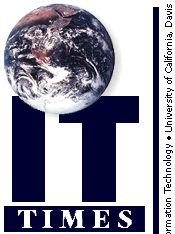
Integrating Technology Into Business Functions
New Skills for New Ways of Working
by Michele PlattenPerhaps nothing more vividly demonstrates the impact technology has on the workplace than the recent introduction and integration of DaFIS, the new campus financial system. DaFIS is just one technology-driven change in a continuum of past, present and future technological workplace integrations. Administrative applications on the scale of DaFIS challenge all of our technical competencies and fundamentally alter the way we get the business of the university done. These new administrative systems don't just automate the old way of doing things, they change the way business is conducted. As knowledge workers, UC Davis staff and managers are being asked to do more complex and subtle tasks involving problem-solving and critical thinking. It is important for us to pay close attention to the challenges posed by the integration of technology into core business functions, from the need for new skills to the need for new ways of thinking and operating.
In 1997, UC Davis sponsored the Partnership Forums series, which brought nationally renowned employment scholars to campus to talk about the effects of new technologies on the campus and on the individuals who have to learn how to use them. Sue Miller Hurst, educator and one of the top thinkers for business strategy and management, underscored the importance of life-long learning as the path to the future for individuals as well as organizations. Jennifer James, urban-cultural anthropologist and author of Thinking in the Future Tense: Leadership Skills for a New Age, shared her insights into technology's impact on the business and the culture of the university. She outlined eight building blocks for workers to understand and adapt to change. William Bridges, author of the seminal works Managing Transitions and Jobshift, described change as a significant event that is followed by a three-phase transition process consisting of an ending, a "neutral zone," and a new beginning. These speakers shared the perspective that technological change is redefining the global future and requires individuals to develop radically new characteristics and outlooks.

UC Davis has long supported campus-based technology training through the campus-sponsored Staff Development & Professional Services (SD&PS) program. SD&PS, in partnership with Information Technology, offers a technology training program that reflects both technical and management consensus about the essential skills and priorities for today's learning organization. The result of this collaboration is the development of a solid core of technology courses, ranging from operating systems to sophisticated database and desktop publishing applications. In October 1997, the Office of Administration, in partnership with the Office of the Provost and Information Technology, opened new staff technology training labs in TB 134 and 135. In addition to this specially designated space in which to hold traditional-style classes, a significant addition to this year's programming is Computer Based Training (CBT). This alternative to instructor-led learning supports efforts by staff to acquire or enhance skills over a broad range of technical topics -- over 300 courseware titles are available for self-study.
By linking business objectives to the capabilities of a new system, we are challenged to consider new ways of working. This in turn leads us to question how to develop what are sometimes radically new skill sets required by these emerging technologies. Staff Development and Professional Services, together with IT Training, is committed to helping UC Davis employees and departments meet these challenges head on, first by recognizing the inevitability of and need for change, by examining and transforming our perspective, and by developing and enhancing our skills.
Michele Platten is co-manager of Staff Development and Professional Services.
Resources
The books referenced in this article are available for checkout by university staff at SD&PS (located in TB 121):- Bridges, William. Managing Transitions: Making the Most of Change, 1991.
- Bridges, William. Jobshift: How to Prosper in a Workplace Without Jobs, 1995.
- James, Jennifer. Thinking in the Future Tense: Leadership Skills for a New Age, 1996.